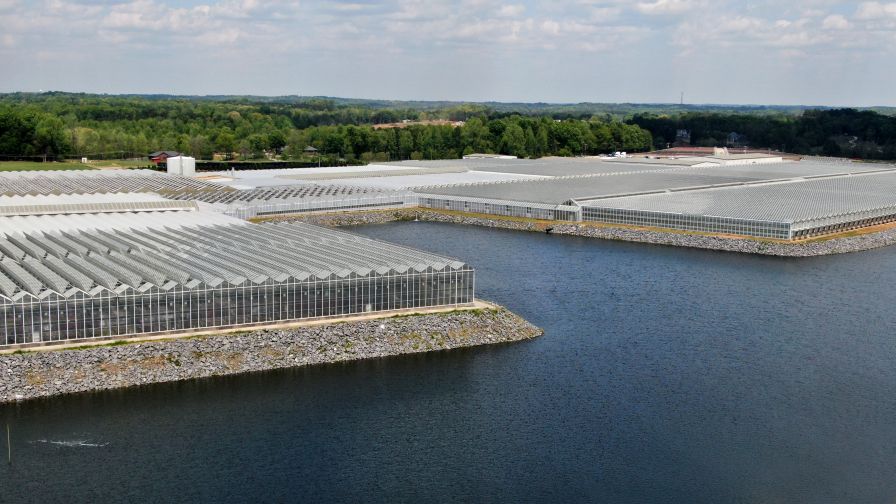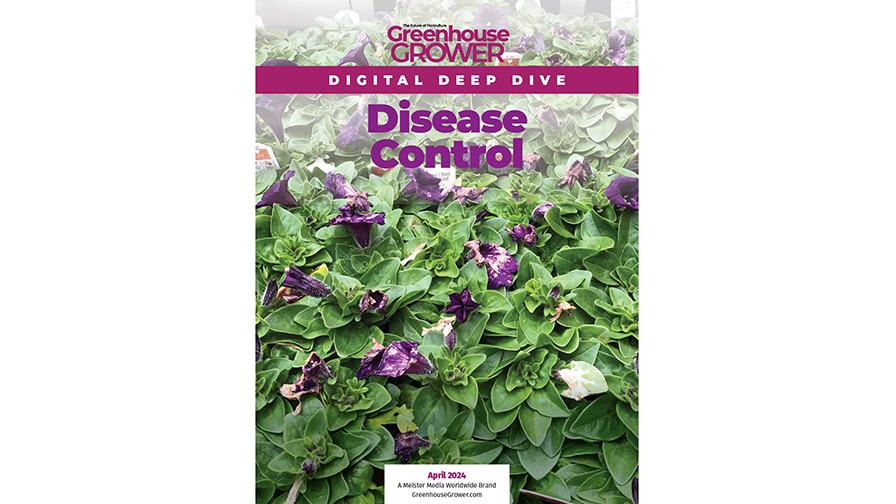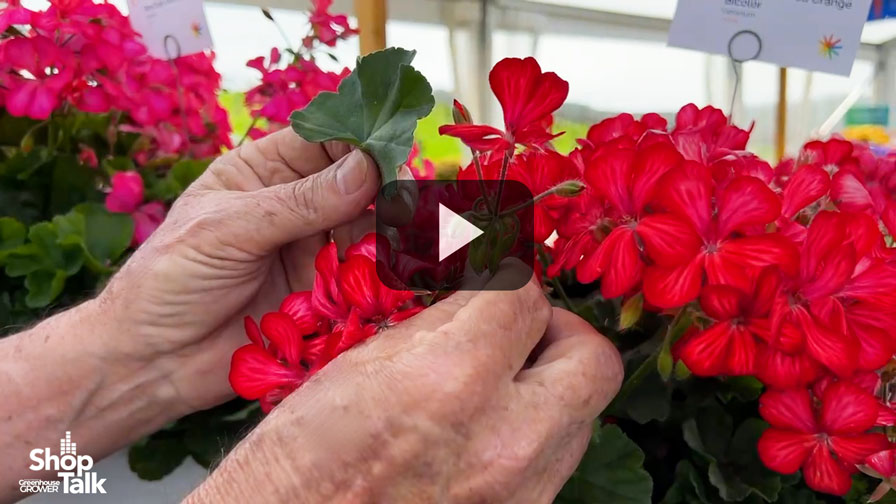Metrolina Greenhouse Celebrates Its 50-Year Anniversary With an Eye on the Future

Metrolina Greenhouses implemented a state-of-the-art water reclamation and recycling system more than 20 years ago. The system makes Metrolina’s growing operations completely self-sufficient and independent, so it doesn’t draw on the local water table.
Metrolina Greenhouses celebrates its 50th year in business this week. Founded in 1972 on 1 acre in Huntersville, NC, by Tom and Vickie VanWingerden, who came to the U.S. from the Netherlands in 1971 with $500 and a dream, Metrolina Greenhouses has grown exponentially over the past 50 years to become one of the largest and most innovative greenhouse operations in the world. The operation spans more than 200 acres of indoor greenhouse production and nearly 300 acres of outdoor production, on a total of 1,000 acres in Huntersville, NC, and York, SC.
Today, Metrolina Greenhouses is owned and led by Tom and Vickie’s six children – Co-CEOs Abe and Art, co-COOs Michael and Thomas, and Board of Directors members Helen and Rose. Metrolina Greenhouses employs 800 year-round, full-time team members with the addition of 400 seasonal workers during peak production.
The high-tech, innovative live goods products and services company grows and supplies 75 million garden plants annually through an omnichannel marketing approach, selling plants at 1,400 retail outlets in 19 states across the Southeast and Mid-Atlantic regions for Lowe’s Home Improvement, The Home Depot and Walmart. In the past year, Metrolina Greenhouses began fulfilling online orders for these retailers, shipping plants directly to consumers’ homes in 50 states.
Co-CEO Abe VanWingerden says his family and business team are thankful to everyone who helped get Metrolina Greenhouses to where it is today, from the previous generation including Metrolina’s founders and the extended VanWingerden family, to Metrolina Greenhouses’ employee team, retail partners, and vendors. VanWingerden adds the company lauds its history while looking at its 50th anniversary as a springboard for the future.
“What I love is, at 50 years we still feel like a young company,” he says. “I see how much more we can accomplish the next 10 years than even what we have done in the last 50 years, because innovation and technology allow us to accomplish our goals so much faster.”
“We’re constantly in full understanding of three big areas: We know where our customers and the gardening consumers are trending and we stay ahead of that, we are the industry leader when it comes to innovation, and we provide a world-class employee experience.”
After two years of record sales and conditions that have reinvigorated consumer interest in gardening, with 20 million new gardeners entering the market, all signs point to continued growth and sales. Although the weather caused a slower start to the spring season in 2022, the conditions are lining up for Metrolina’s 50th year to be another excellent, record-breaking year, setting the pace for the future.
“All of our data shows that consumers are still very into gardening,” Van Wingerden says. “In the last two cycles of inflation and economic slowdown, in 2008 and 2015, the live goods space remained strong. People went out less, drove less and invested in fewer big projects. Gardening is a high-time, low-dollar investment hobby, so more people got into it. Our consumer data shows that they are hooked and will continue to invest in plants and gardening.”
As sales volume continues to grow 3% to 5% annually for Metrolina’s retail partners, the greenhouse operation will grow along with it, says Metrolina Greenhouses co-CEO Art VanWingerden.
“If Walmart, Lowe’s, and Home Depot grow sales 3% to 5% a year, we have to produce 3% to 5% more product, so really, we need 12 more acres of heated greenhouses and 12 more acres of outdoor space every year,” he says. “If you’re static and you’re not innovating and expanding, you cannot keep up with demand.”
Metrolina has consistently expanded at a rate of approximately 12 to 14 acres per year, along with the growth of its retail partners, Art VanWingerden says.
“Nobody would have ever dreamed Metrolina would be the size it is today,” he says. “We’re adding more acres per year than what Dad originally thought we were going to be. He thought if we could get to 12 acres, we’d be set – we’d never have to add on again.”
The legacy of the past 50 years is important, according to Art VanWingerden, but the main driver for the business today is sustainable, strategic growth.
“We want to be sure we’re building a successful business for the employees we have and the customers we’re serving.”
5 Ways Metrolina Greenhouses is Earth-Friendly Every Day
Metrolina is observing Earth Day this year by highlighting its sustainability efforts and ongoing commitment to Earth-friendly initiatives.
Art VanWingerden points out that the environmentally sustainable practices Metrolina Greenhouses has adopted over the years have helped the company remain financially sustainable.
“We do all of these things because they’re good for the environment, but they’re also good for business,” he says.
Here are five ways Metrolina Greenhouses has committed to sustainable practices:
- 100% Water Reclamation: Metrolina Greenhouses implemented a state-of-the-art water reclamation and recycling system more than 20 years ago. The system makes Metrolina’s growing operations completely self-sufficient and independent, so it doesn’t draw on the local water table. In peak production, Metrolina Greenhouses uses up to 1 million gallons of water per day, so having its own constant supply of extremely clean and plentiful water is essential. Through Metrolina’s extensive water system, it can reclaim water from weather events in multiple retention ponds at both locations. For every inch of rain that falls onto its two campuses, the operation can recycle it into 5 million gallons of clean, fresh water at the greenhouses in Huntersville, North Carolina and 1 million gallons at its farm in York, SC.
- Recycling: Metrolina Greenhouses partnered with each of its three major customers to implement a recycling program, starting in 2010. To date, Metrolina Greenhouses’ plastic recycling program reclaims, reuses or recycles up to 6 million pounds of plastic annually that would otherwise end up in landfills. With its plastics recycling and reuse program firmly in place, both internally and at its retail customers’ stores nationwide, Metrolina is committed to recycling a minimum of 15 million pounds of plastic annually by 2030.
- Energy: Metrolina Greenhouses fired up its Vynke biomass boiler system from Belgium in 2009. The wood boilers cover at least 95% of the operation’s heating needs at the Huntersville main campus. Metrolina sources 100% of the wood it uses locally, from recycled wood pallets and construction and timber industry byproducts, which are then made into woodchips to feed the biomass boilers. Using reclaimed wood byproducts that would otherwise be thrown away helps the environment and boosts the local economy.
- Biocontrols: Metrolina’s research and development team began investigating methods to reduce its chemical and pesticide use throughout the company nearly 10 years ago. In 2015, the team introduced the use of biological controls, including biologically or naturally derived pesticides, beneficial insects and predatory insects to eliminate insect pests.
A combination of strict sanitation procedures and the use of biocontrols also helps the operation reduce or eliminate plant diseases, keeping crops as healthy and productive as possible. These efforts have resulted in a 25% reduction of chemicals by 2021, including the complete elimination of the neonicotinoid class of pesticides.
Metrolina Greenhouses has earned several distinctions and memberships in top-level climate-focused organizations through its sustainability efforts. Metrolina reports its water, energy, and control-product use and has submitted its carbon emissions goals to these organizations:
- Carbon Disclosure Project. https://www.cdp.net/en
- Science Based Targets Initiative. https://sciencebasedtargets.org/
- Floriculture Sustainability Initiative. https://www.fsi2025.com/
- MPS. https://my-mps.com/?lang=en
“When you’re dealing with a complex supply chain, trucking and things of that nature, plus 1,400 retail outlets in a recycling program, there is no one entity that can encompass all of that,” said Abe VanWingerden. “We found that we need to partner with several organizations because each provides their own unique area of expertise for our sustainability goals.”









